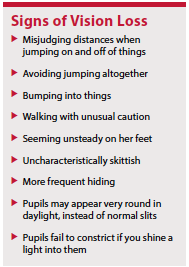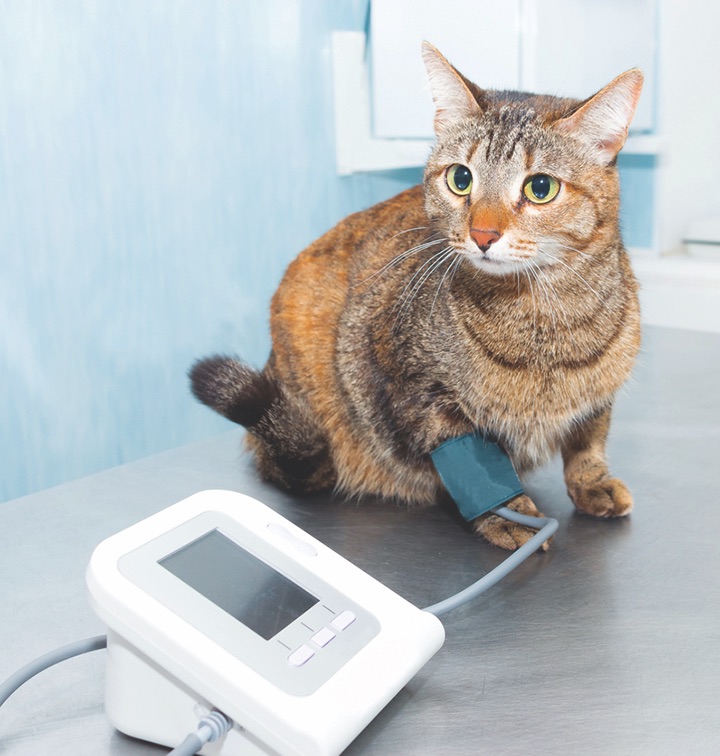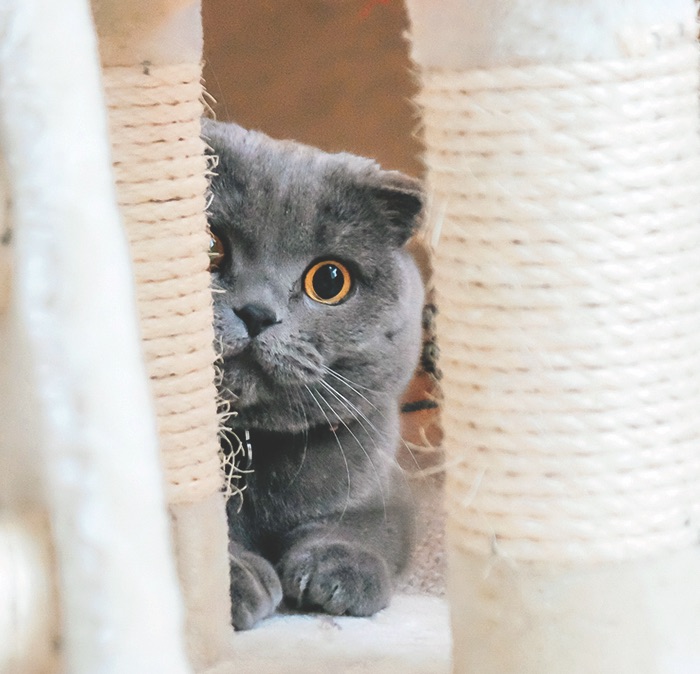Cats are notoriously good at hiding early symptoms of disease, often providing few clues until things get so bad that normal functioning is impossible. This often makes it seem like they are suddenly severely ill when just yesterday they appeared fine.
But that’s rarely what happens, and vision loss is a classic example. The reality is that, until reduced vision reaches a point where your cat can no longer navigate, you may not be aware that there’s a problem.
“Loss of vision caused by intraocular inflammation typically has a more insidious course but may present as ‘sudden vision loss,’ as many cats may not have obvious behavioral changes until advanced stages of disease,” says Kelly Knickelbein, VMD, assistant clinical professor of ophthalmology at Cornell University’s College of Veterinary Medicine.
 Regardless of whether it is truly an acute situation or whether vision loss was coming on gradually and you were unaware, perceived sudden blindness in cats is always an emergency. If there is any chance of restoring and preserving vision, the sooner a diagnosis is made and treatment is instituted, the better the chance of recovery.
Regardless of whether it is truly an acute situation or whether vision loss was coming on gradually and you were unaware, perceived sudden blindness in cats is always an emergency. If there is any chance of restoring and preserving vision, the sooner a diagnosis is made and treatment is instituted, the better the chance of recovery.
Causes of Vision Loss
In order to see, light must first pass through all layers of the eye (cornea, anterior chamber, pupil, lens, posterior chamber), hit the retina, and be transferred via the ocular nerve to the brain. Anything that disrupts this passage at any point along the way interferes with vision.
In addition to eye diseases themselves, there are systemic disorders—those that affect an entire system in the body—that cause “sudden” blindness. The most common in cats are low blood sugar (hypoglycemia) and high blood pressure (hypertension). Low blood sugar is most often seen in diabetic cats who receive too much insulin. Hypertension is most often caused by chronic renal failure or hyperthyroidism in cats.
Be sure to tell your veterinarian about all medications your cat is on. Some drugs have the potential to cause blindness, such as the fluoroquinolone antibiotic enrofloxacin (Baytril), a drug used to treat particularly persistent bacterial infections. Enrofloxacin is potentially toxic to the retina in cats.
It’s kind of a big deal because the retinal toxicity is idiosyncratic, which means there’s no telling which cats it will happen to or why. Worse, the blindness is usually permanent. It is more likely to happen in older cats, at higher dosages, and with extended treatment. Other fluoroquinolones can potentially harm eyesight as well, but enrofloxacin is the only one with which cases have been documented. If there is an appropriate antibiotic alternative for your cat, it’s best to avoid enrofloxacin.
Taurine is an essential amino acid in cats. Dietary taurine deficiency causes retinal degeneration and blindness. As long as you feed your cat a good quality commercial cat food, however, this is not usually a concern. It can be a big concern for cats eating diets that are not nutritionally complete and balanced. This is most commonly seen with homemade diets that are prepared by owners with good intentions but without the guidance of a veterinary nutritionist.
Retinal Diseases
Far and away the most common cause of sudden blindness in cats is retinal detachment secondary to hypertension. This usually happens in older cats, as chronic renal failure and hyperthyroidism are more common in this age group. Your veterinarian can usually identify detached retinas during an ophthalmic exam and can measure systemic blood pressure to identify hypertension.
In veterinary medicine, the primary focus with blood pressure measurement is the “top” number, which is the systolic pressure, or pressure in the arteries when the heart contracts. Anything above 160 mm Hg (milligrams of mercury) is considered too high. If your cat is hypertensive and has detached retinas, bloodwork should be done to identify underlying disorders and medication to reduce blood pressure should be started right away. Some hypertensive cats, if caught early enough, will regain vision.
“In terms of cats with hypertensive retinopathy, the prognosis for the return of vision depends on how chronic the retinal disease is and whether the underlying systemic disease causing the hypertension can be managed,” says Dr. Knickelbein. “Cats with more chronic retinal detachments are less likely to regain vision, and some cats may undergo retinal degeneration following reattachment of the retina, resulting in permanent vision loss.”
Even if detached retinas are not identified on your suddenly blind cat, systemic blood pressure should always be measured, as hypertension can result in vision loss due to brain disease (hypertensive encephalopathy). Other brain disorders that cause blindness include seizures (including the time following a seizure called the post-ictal period), anesthetic complications, inflammatory or infectious brain diseases, and cancer. Post-ictal and post-anesthetic blindnesses are usually temporary.
Progressive retinal atrophy (PRA) has been documented in the Abyssinian cat and more recently identified in the Bengal. While it is usually a slowly progressive retinal degeneration, it sometimes seems to cause sudden blindness, due to cats’ previously referenced ability to hide early dysfunction. Unfortunately, there is no treatment for PRA, and affected cats will usually go completely blind within a year or two of diagnosis.
Corneal Disease
Corneal disease affecting vision is typically pretty apparent to the pet owner, as the
normally clear cornea has to become pretty opaque in order to prevent the passage of light. Trauma, corneal ulcers with associated corneal edema (a bluish haze), inflammation of the cornea (keratitis) most frequently caused by feline herpesvirus, and corneal sequestrum (a localized area of dense, discolored tissue) most frequently caused by feline herpesvirus are examples of corneal disease that can interfere with vision. Again, it’s usually obvious that something is wrong, which means you can should be able to get your cat to the veterinarian early in the course of disease so she can receive potentially vision-saving treatment.
Anterior uveitis (AU) is inflammation of the middle layer of the eye, which includes the iris (the colored portion of the eye) behind the cornea. AU is harder for a pet owner to spot, especially early on, but signs might include excessive tearing, squinting, sensitivity to light, and third eyelid protrusion. The iris may appear swollen and/or change colors, the pupil is usually constricted (which makes it look like a vertical slit), and blood or cellular matter might be visible in the anterior chamber (the space between the cornea and the iris).
AU can be caused by penetrating trauma to the eye, but most often occurs secondary to systemic disease somewhere else in the body. Hence, your veterinarian will recommend an “antigen hunt” for your cat. An antigen is anything that induces an immune response in the body. Common antigens in cats with uveitis include infectious agents (bartonella, feline leukemia virus, feline immunodeficiency virus, feline infectious peritonitis, toxoplasma, feline herpesvirus, fungal infection) and cancer (lymphoma).
While AU may interfere with your cat’s vision, the secondary problems it causes—such as cataracts, lens luxation (dislocation), and glaucoma—are what usually result in blindness. Fortunately, cats with cataracts usually respond favorably to surgery. Lens luxation may require medical and surgical treatment. Glaucoma in cats is generally refractory to treatment, causes blindness, and is painful, so the recommendation is usually surgical removal of the eye (enucleation). Primary cataracts and primary glaucoma, i.e., not caused by AU, are not common in cats.

Optic neuritis (inflammation of the optic nerve) usually results in sudden blindness. Like AU, it can be caused by infectious diseases (feline infectious peritonitis, toxoplasma, fungal infection) and cancer (lymphoma). If no causative antigen is identified, symptomatic therapy with steroids sometimes restores vision, but the prognosis for vision with this disease is always guarded.
Sudden blindness is not exceedingly common in cats, but it does happen. When it does, it is always an emergency. Getting your cat to the veterinarian as soon as possible could mean the difference between a return of vision and permanent blindness.




